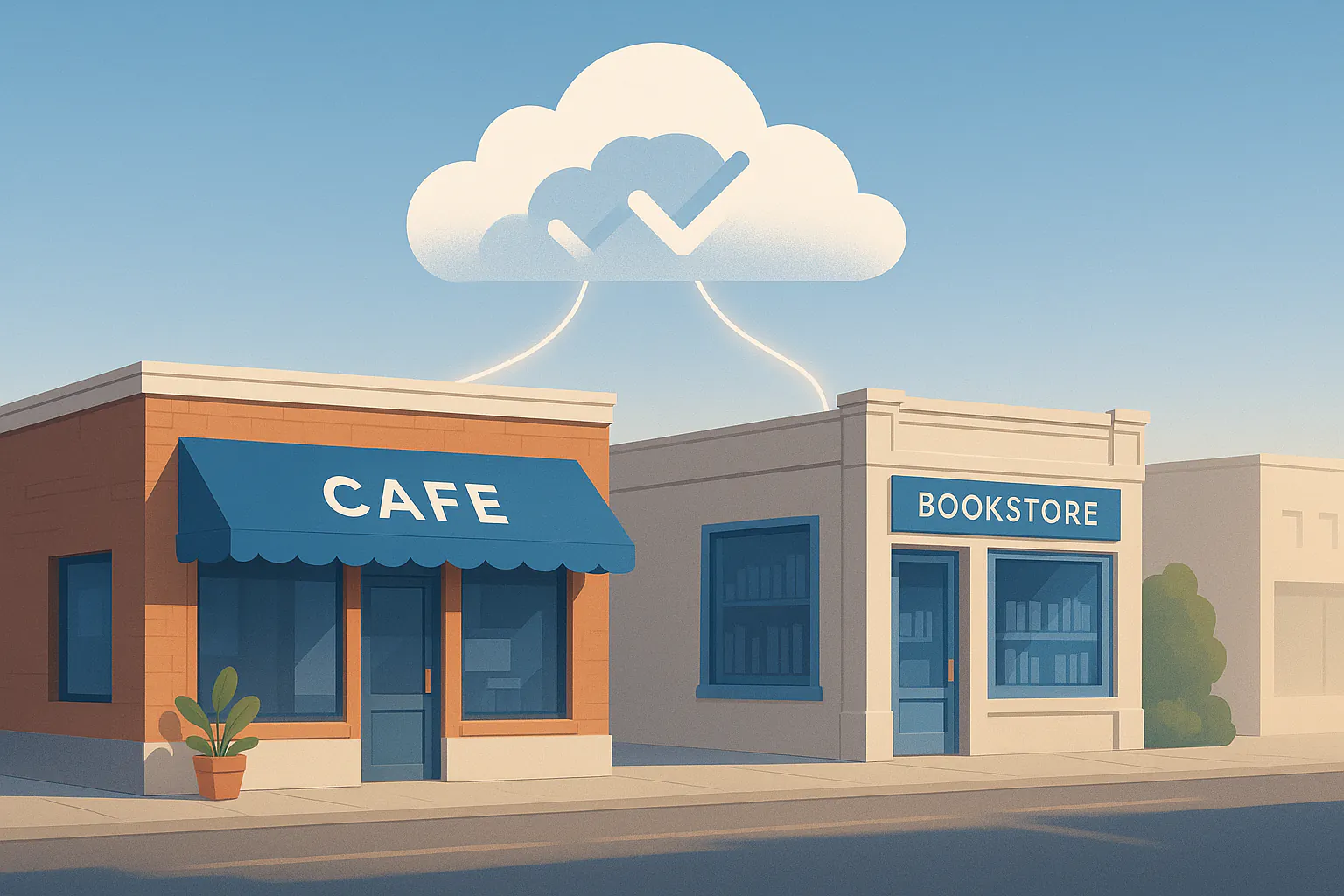Cloud Based Solutions for Small Business: Framework, Budget, Governance
Key Takeaways
- Cloud based solutions for small business work best when identity, backups, and budgets are set first.
- A simple model of SaaS, PaaS, and IaaS helps you choose tools that fit your needs and skills.
- Small, staged changes like MFA, shared storage, backups, and one managed app deliver quick wins without disruption.

Learn what cloud based solutions for small business include, when to use them, and the easiest way to put them in place. You will see a simple framework, plain trade-offs, costs to expect, and a checklist you can reuse with your team. When you are ready, Yocum Technology Group can plan and execute a clean move to the cloud and help you modernize at the right pace.
What “Cloud” Means For A Small Business
Cloud is not one thing. It is a menu of hosted services you rent instead of owning the hardware and running it yourself. For small companies, that menu usually includes:
- Email and collaboration
- File storage and sharing
- Line-of-business apps you access in a browser
- Data backup and recovery
- Security, identity, and device management
- Application hosting for custom tools
Yocum Technology Group supports these areas and also handles full cloud migration and modernization when you outgrow basic tools.
Quick Wins You Can Put In Place First
Start with the pieces that return value fast and do not require big change:
- Managed identity and sign-on. One login for your team across apps, with multifactor authentication and single sign-on. This improves security and reduces password resets.
- Shared file storage and permissions. Central spaces for teams, simple permissions, and predictable backups.
- Automated backups for email, files, and key SaaS data. Recover files and mailboxes in minutes, not days.
- Endpoint management. Standard settings for devices, remote wipe, and software updates on a schedule.
These steps reduce risk and daily friction and set you up for later moves like application hosting or data integration. YTG can help design and implement these basics, then extend them into a full plan.
The Core Framework: SaaS, PaaS, IaaS
Use this model to match needs to services.
Software as a Service (SaaS)
You rent the finished app. Examples include CRM, help desk, accounting, and HR systems. You manage users and data. The vendor handles the app and the servers. Pros: fast to adopt, low maintenance. Cons: limited customization.
Platform as a Service (PaaS)
You focus on your code while the platform handles runtime, scaling, and patches. Good for custom apps that must ship fast and scale later. Pros: faster releases, fewer servers to manage. Cons: requires basic developer skills.
Infrastructure as a Service (IaaS)
You rent virtual machines, storage, and networks and configure them like your former servers. Pros: full control, easy “lift and shift.” Cons: you still manage the operating system and updates.
YTG plans and executes these models as part of cloud migration and modernization services, with an approach that reduces risk and keeps work moving.
Where Cloud Helps Most In A Small Business
Email, Calendar, and Collaboration
Cloud suites give reliable mail, shared calendars, team chat, and meetings. Add data loss prevention, retention policies, and basic device controls to keep data safe and meet simple compliance needs. This is usually the first move.
File Storage and Team Workspaces
Replace shared drives with team sites and document libraries. Use permissions based on role, not one-off folders. Turn on version history and recycle bins so mistakes are easy to fix.
Line-Of-Business Apps
Accounting, sales, project tracking, and support can live in SaaS with built-in backups and integrations. If a SaaS app does 80 percent of what you need, do not rebuild it. If you need something unique, consider a lightweight custom web app hosted in the cloud. YTG builds and hosts custom applications and can integrate them with your systems.
Backup And Recovery
Backups are not optional. Use a simple rule of three copies on two types of storage with one off-site. For cloud suites and SaaS tools, add a third-party backup so you can restore single items quickly. For custom apps, set automatic snapshots and test recovery quarterly.
Security And Identity
Turn on multifactor authentication, conditional access, and single sign-on. Keep admin accounts separate. Enforce basic device policies. Log and review sign-ins and file sharing regularly.
Hosting For Custom Apps
If you have in-house tools or a small database, host them on managed services so updates and scaling are simpler. YTG can move legacy apps, trim fragile code, and place workloads on Azure or other major platforms with clean cutovers and wave-based plans.
A Decision Tree You Can Use
Use these questions to choose your next move.
- Does a SaaS product meet at least 80 percent of the need?
Yes: pick SaaS and integrate. No: go to 2. - Do you need a custom workflow that changes often?
Yes: consider PaaS or a managed container platform. No: go to 3. - Do you need full server control or special licenses?
Yes: choose IaaS, then modernize later. No: keep PaaS in scope. - Is the app legacy but stable and hard to change?
Use a staged “lift and shift” to IaaS, then plan a refactor when you have time.
YTG uses the familiar “Rs of migration” to apply this logic workload by workload, from rehost to refactor, with clear pros and cons.
Cost: What To Expect And How To Control It
Cloud costs are predictable when you plan them. Use these controls:
- Right-size resources. Start small and increase if needed.
- Turn off what you do not use. Schedule dev and test systems to shut down outside work hours.
- Use reserved or savings plans when stable. Commit for one to three years for steady workloads.
- Set budgets and alerts. Track spend daily, not monthly.
- Watch data egress. Moving data across regions or out of a cloud can add cost. Keep heavy data near the apps that use it.
YTG designs budgets and guardrails during planning so your team can see and manage spend from day one.
Reliability And Recovery
- Design for failure. Assume a component may go down. Use multiple zones or backups.
- Backups and snapshots. Automate and test restores with real scenarios.
- Runbooks. Write short, step-by-step guides for outages and keep them easy to find.
- Incident drills. Practice twice a year. Time the team. Fix the gaps.
Security Basics That Make A Big Difference
- Multifactor authentication for every user
- Admin accounts without mailboxes or daily use
- Conditional access rules for risky sign-ins
- Device encryption and automatic screen locks
- Least-privilege access
- Regular review of shared links and external guest accounts
Security grows in layers. Start with identity, then device and data, then app controls. YTG builds policies that match your size and risk and scales them over time.
Data And Integration
Small businesses often have five to ten core apps that need to share data. Start with a simple map:
- Which system is the source of truth for each type of data
- Where that data needs to go and how often
- What fields must match
- What to do when data conflicts
Phase one may be light automation between two systems. Phase two might add a data store or webhook. If you outgrow simple flows, YTG can build a small, reliable integration service and host it on managed cloud services.
Multi-Cloud Without The Pain
Many small companies end up with more than one cloud because different apps come from different vendors. Keep this sane by:
- Picking one primary platform for identity and monitoring
- Centralizing audit logs
- Using shared naming and tagging
- Keeping networking simple and documented
YTG helps small teams anchor on Azure while connecting other services cleanly and keeping governance simple.
A Simple 30-60-90 Day Plan
Days 1–30: Baseline and Fast Fixes
- Inventory users, devices, apps, and data locations
- Turn on multifactor authentication and basic device policies
- Move shared files to team storage with clear permissions
- Set up backups for mail and files
- Define a budget with alerts
Days 31–60: Platform Setup
- Choose SaaS apps to replace aging tools
- Pilot single sign-on for your top three apps
- Draft your recovery plan and test one restore
- If needed, create a small landing zone for future app hosting
Days 61–90: First Modernization
- Pick one small internal app or integration with clear value
- Host it on a managed platform and connect it to identity
- Measure adoption and support requests
- Plan the next two quarters by applying the decision tree
YTG uses this staged approach to protect daily work while improving your stack one clean step at a time.
Common Traps And How To Avoid Them
- Skipping identity. Password sprawl and risky sharing follow. Fix identity first.
- Lifting and shifting everything. Costs climb and you miss easy wins. Select by workload.
- No budgets or tags. You cannot see where money goes. Tag resources and set alerts.
- Shadow IT. Unapproved tools lead to lost data and weak access control. Offer approved options and make them easy to use.
- No owner. Assign a single person to each system, even if part-time.
What Yocum Technology Group Brings
- Planning and execution. YTG builds migration waves, sets landing zones, and manages cutovers so work keeps moving.
- Modernization while you migrate. Trim fragile code and use managed services where they fit.
- Visibility on spend. Right-sized resources, cost guardrails, and simple monitoring.
- Sane governance. The smallest set of policies that keep you safe and productive.
This is the same approach YTG outlines across its services and recent guides on migration and multi-cloud planning.
Buyer’s Guide: How To Evaluate Vendors
- Evidence of staged plans. Ask for a two-page plan with milestones and rollback.
- Clarity on ownership. Who owns identity, backups, and cost alerts after cutover.
- Runbook samples. Look for short, checked-in steps for incident response.
- Right-sizing method. How they pick instance sizes and monitor them.
- Security baseline. MFA, admin separation, and device policies from day one.
- Support model. Who you call, and what the response times are.
Case Pattern: The Typical First Three Months
A 25-person firm with shared drives and a few aging servers wanted better collaboration and faster releases for a small internal tool. The plan:
- Month 1, identity and files: one login for all, team sites for files, backups on a schedule
- Month 2, SaaS choices: move help desk to a hosted tool, connect to single sign-on
- Month 3, custom app: host the internal app on a managed platform with a small database
Outcomes: fewer password resets, less file confusion, fewer manual exports, and a first custom feature shipped in week 10. This is common because it picks the lowest-risk path with clear returns.
How To Roll This Out With A Small Team
- Assign one owner per stream: identity, files, SaaS, and custom apps.
- Meet weekly for 30 minutes. Track decisions in a shared document.
- Use a parking lot for later ideas so the plan stays short.
- Keep a living checklist and mark done with dates.
- Share simple training links and record two-minute screen captures for common tasks.
What “Best Cloud Computing For Small Business” Really Means
People ask for the best cloud computing for small business as if there were one choice. The best option is the one that reduces friction, protects data, and keeps costs clear. That usually means:
- SaaS for common needs you should not rebuild
- A small, managed platform for light custom work
- Identity, backup, and budgets baked in
- Clear owners and runbooks
- A partner who can help you modernize only where it pays off
For small teams, this mix gives speed now and room to grow later. YTG provides that path and helps you move at a pace your team can handle.
Next Step
If you want a practical plan, start with a short discovery session. You will get an inventory, a two-stage roadmap, and clear budget ranges. When you are ready, YTG can run the migration and modernize the parts that matter.




